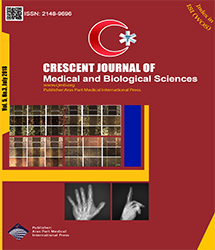
| Original Article | |
| Impact of Mummy Substance on Proliferation and Migration of Human Wharton's Jelly-Derived Stem Cells and Fibroblasts in an In Vitro Culture System | |
| Shahnaz Sabetkam1,2, Jafar Soleimani Rad1, Sepideh Hassan Pour Khodaie1,2, Sepideh Hassan Pour Khodaie1,2, Masood Maleki1, Leila Roshangar1 | |
| 1Stem Cell Research Center, Tabriz University of Medical Sciences, Tabriz, Iran 2Department of Anatomical Sciences, Faculty of Medicine, Tabriz University of Medical Sciences, Tabriz, Iran |
|
|
CJMB 2018; 5: 233–240 Viewed : 6276 times Downloaded : 10340 times. Keywords : Cell migration and proliferation, HFFF-2, Mummy Substance, WJSCs, Wound healing |
|
| Full Text(PDF) | Related Articles | |
| Abstract | |
Objectives: Because of the high prevalence of chronic wounds, wound repair has become one of the health challenges. Numerous therapeutic strategies have been proposed for repairing wounds and recently, the use of herbal medicines has been considered because of lower costs and complications. The use of mummy is recommended in traditional medicine for treating bone fractures, bleeding control, poisoning treatment, headache relief and wound repair. Therefore, the purpose of the present study was to provide a scientifc assessment of the effect of mummy on wound healing. Materials and Methods: Human fetal foreskin fbroblast cells (HFFF-2) were purchased from Pasteur Institute (Tehran, Iran). The fbroblast cell lines and stem cells derived from Wharton’s jelly (WJSCs) were isolated by means of explant culture. MT assay was used to determine the effective concentration of mummy. Scratch assay method was used to examine the effect of mummy on cell migration rate and flow cytometry was used to assess the rate of cell proliferation using Ki-67 antibody. WJSCs and HFFF-2, each under mono-culture and two-cell co-culture condition with 50-50 and 30/70 ratio respectively, were in an experimental group including culture medium and mummy and in a control group including culture medium only. Results: Scratch assay results for HFFF-2 cell migration showed a signifcant increase (P≤0.0001), but the mummy had no signifcant impact on WJSCs and a signifcant increase was observed in 50/50 and 30/70 co-culture conditions with P≤0.001 and P≤0.0001, respectively. The proliferation rate of WJSCs increased signifcantly while no signifcant increase was found in fbroblast groups in mono-culture and co-culture conditions. Conclusions: Results showed that by stimulating fbroblast cell migration both in mono-culture and co-culture conditions with stem cells and by increasing WJSCs proliferation, the mummy can be used as a treatment to accelerate wound repair procedure. |
Cite By, Google Scholar
Google Scholar
PubMed
Online Submission System
 CJMB ENDNOTE ® Style
CJMB ENDNOTE ® Style
 Tutorials
Tutorials
 Publication Charge
Medical and Biological Research Center
About Journal
Publication Charge
Medical and Biological Research Center
About Journal
Aras Part Medical International Press Editor-in-Chief
Arash Khaki
Deputy Editor
Zafer Akan


















